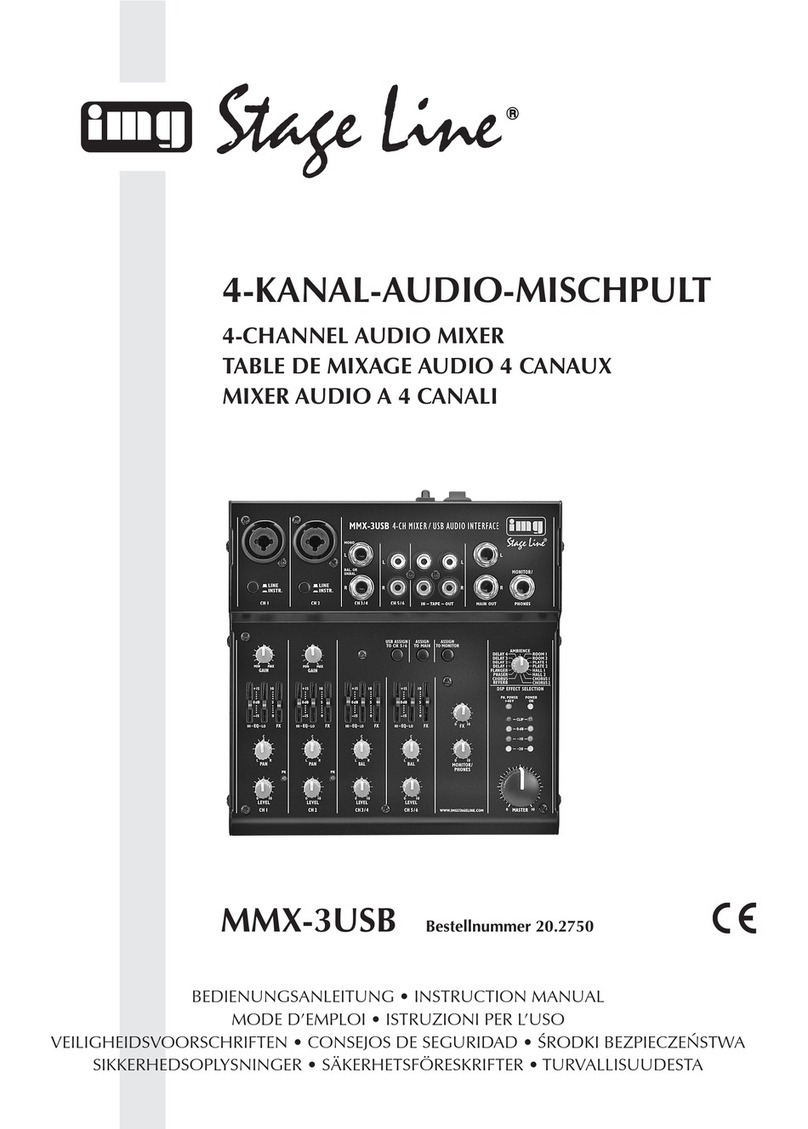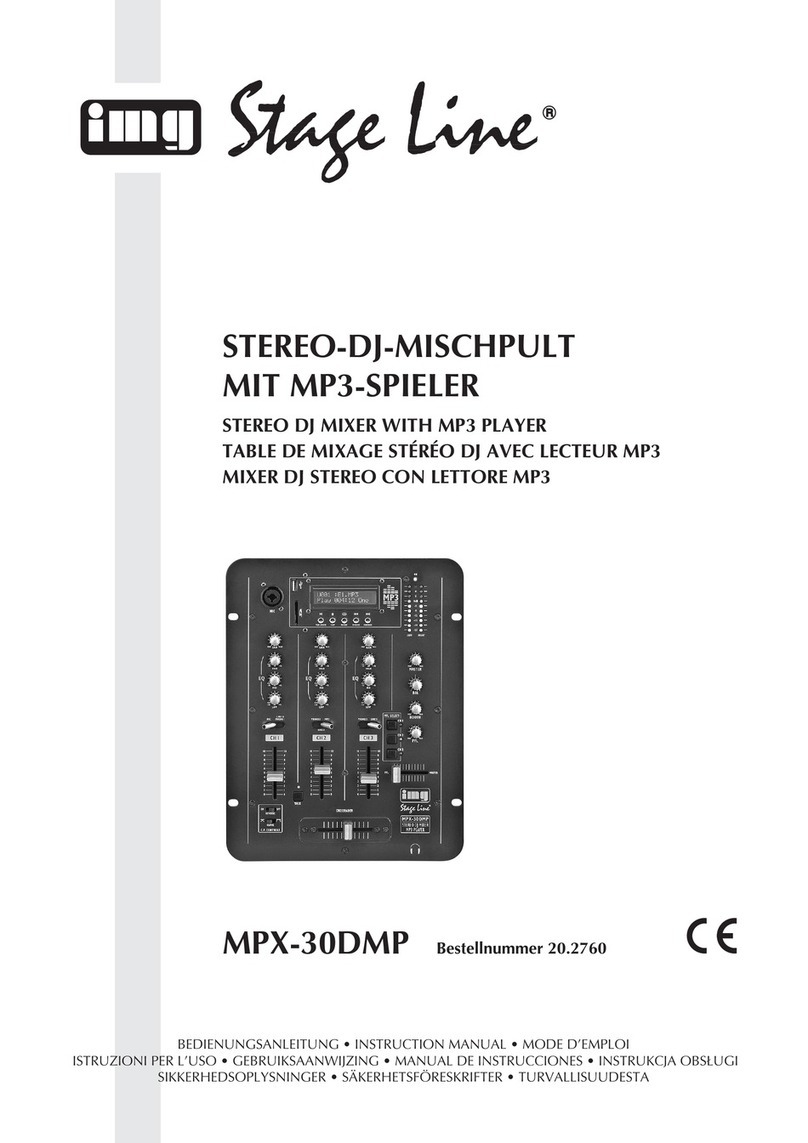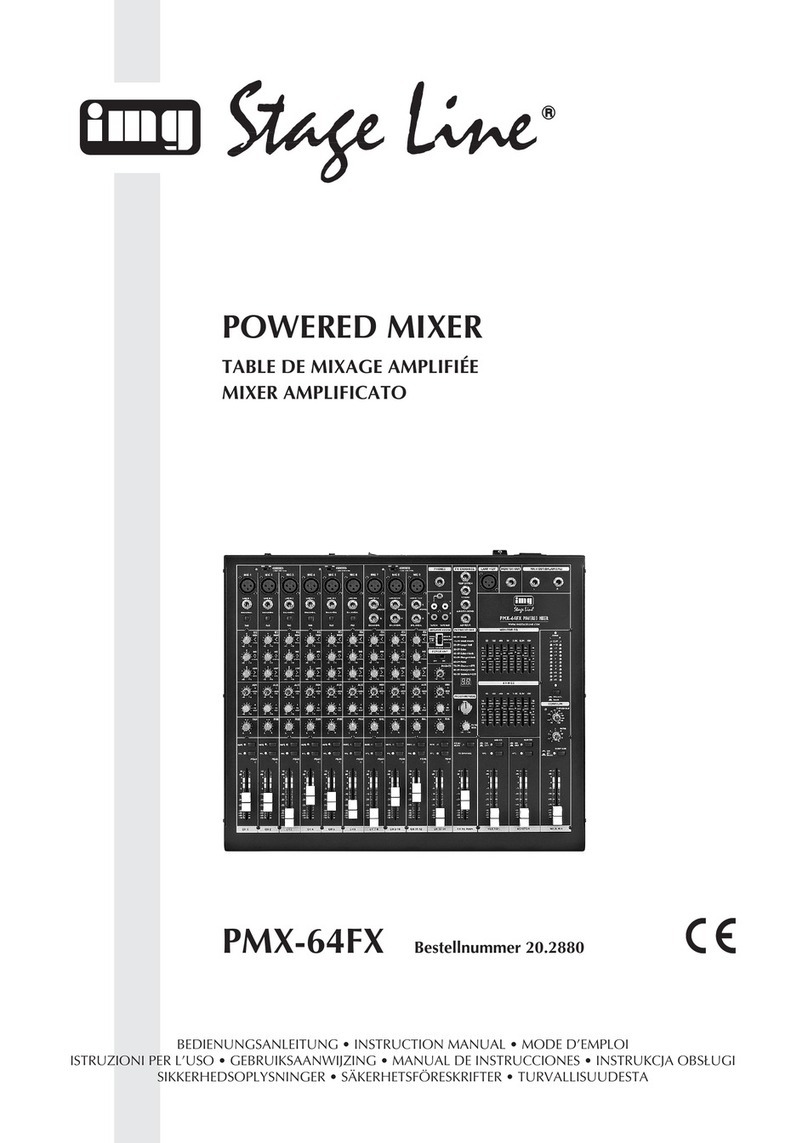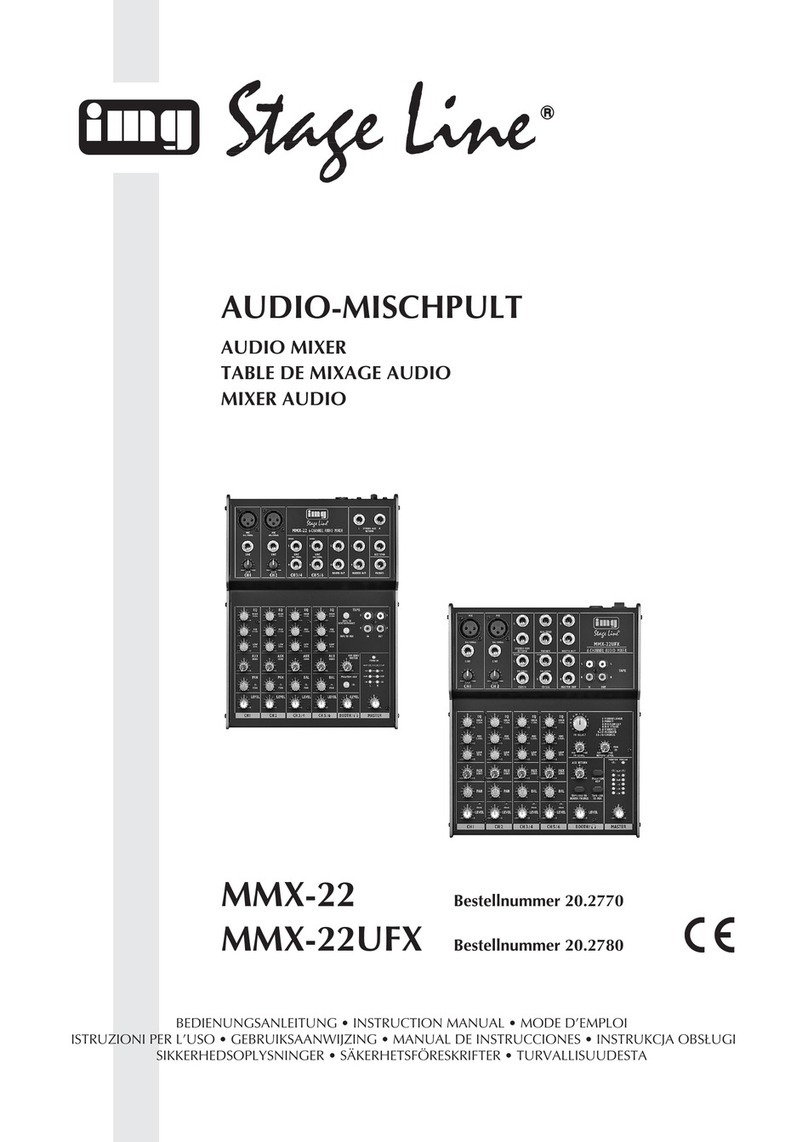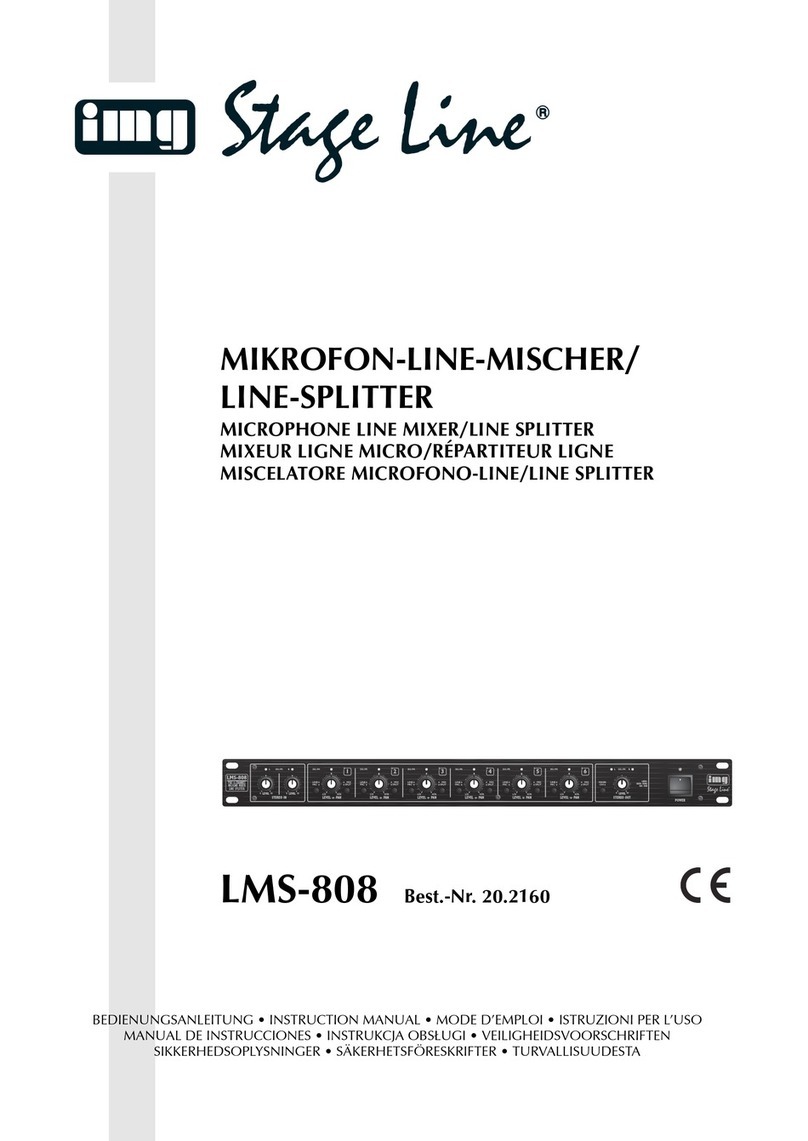1) Zum Einschalten der Mikrofone an den Mikrofon-
kanälen DJ MIC, GUEST 1 und GUEST 2 die ent-
sprechenden Tasten ON AIR (17) drücken.
2) Mit den Umschalttasten (3) die an den Kanälen
1–5 angeschlossenen Signalquellen anwählen.
Taste nicht gedrückt ( ):
Der Eingang LINE des Kanals ist angewählt.
Taste gedrückt ( ):
Der Eingang PHONO (bei Kanal 1 und 2) bzw.
CD (bei Kanal 3–5) ist angewählt.
3) Mit den beiden Masterfadern wird der Gesamt-
pegel aller angeschlossenen Tonquellen einge-
stellt, der an den Masterausgängen zur Ver-
fügung steht: Masterfader A (31) für die beiden
Masterausgänge A (36), Masterfader B (30) für
den Masterausgang B (37).
Den Regler desjenigen Masterkanals, der für
die Grundeinstellung der Eingangskanäle ge-
nutzt wird, auf ca. 2/3des Maximums, z.B. auf
Position 7, stellen.
4) Mit dem Drehschalter DISPLAY (25) das Stereo-
VU-Meter (5) auf denjenigen Masterkanal einstel-
len, der für die Grundeinstellung der Eingangs-
kanäle genutzt wird.
5) Zum Aussteuern eines Kanals die Fader (15) der
übrigen Kanäle auf Minimum stellen und die Ton-
signale (Testsignale oder Musikstücke) auf den
jeweiligen Eingangskanal geben.
6) Anhand des Stereo-VU-Meters mit dem Kanal-
fader den Pegel des Kanals ausregeln. Die Aus-
steuerung ist optimal, wenn bei den lautesten
Passagen der 0-dB-Bereich des VU-Meters kurz
aufleuchtet. BeiAnzeigen über 0dB ist der Kanal
übersteuert. Der Fader sollte nach der Pegelein-
stellung auf ca. 2/3des Maximums stehen, damit
zum Ein- und Ausblenden genügend Reglerweg
vorhanden ist.
Bei sehr wenig oder sehr weit aufgezogenem
Fader muß der Pegel durch Regulierung der Ein-
gangsverstärkung angepaßt werden: Den Gain-
Regler (9) des Kanals entsprechend zurück- bzw.
aufdrehen. Für die Kanäle 1 bis 5 und die beiden
Mikrofonkanäle GUEST 1 und 2 dient dabei das
PFL-VU-Meter (7) als Kontrolle: Den Regler MIX
(23) auf Position „PFL“ schieben, und die Taste
PFL(18) des Kanals drücken. Das PFL-VU-Meter
zeigt dann den Signalpegel des Kanals vor dem
Kanalfader an.
7) Mit den Klangreglern des Kanals das gewünsch-
te Klangbild einstellen:
Regler HIGH = Höhenbereich (20kHz)
Regler MID-H = oberer Mittenbereich (3kHz)
Regler MID-L = unterer Mittenbereich (300Hz)
Regler BASS = Tiefenbereich (20Hz)
Alle Frequenzbereiche können bis max. 15dB
angehoben bzw. gesenkt werden.
Stehen die Regler in Mittelstellung, findet kei-
ne Frequenzgangbeeinflussung statt.
Hinweis: Klangeinstellungen wirken sich auf die
Pegel aus. Deshalb nach einer Klangregulierung
den Kanalpegel anhand des Stereo-VU-Meters
kontrollieren und ggf. korrigieren.
8) Die Einstellungen für die übrigen belegten Ein-
gangskanäle in der gleichen Weise wie oben be-
schrieben durchführen.
5.1.2 Einstellungen für die Monitoranlage
Die drei Mikrofonkanäle und die Stereo-Kanäle 1–5
können über eine am Ausgang MONITOR (38) an-
geschlossene Monitoranlage abgehört werden. Der
Monitorweg ist ein Pre Fader-Weg, d.h. die Kanal-
signale werden noch vor den Kanalfadern (15) auf
den Monitorweg gelegt.
1) Um einen Kanal bzw. mehrere Kanäle auf den
Monitorweg zu schalten, die Taste MON (14) des
jeweiligen Kanals drücken.
2) Den Schalter DISPLAY (25) auf die Position
„MONITOR“ stellen. In dieser Position zeigt das
Stereo-VU-Meter (5) den Pegel am Monitoraus-
gang an.
3) Mit dem Monitorfader (29) den gewünschten Pe-
gel für die Monitoranlage einstellen. Bei Über-
steuerungen (rote LEDs des VU-Meters leuchten
auf) den Fader entsprechend zurückregeln.
5.1.3 Einstellungen bei Verwendung eines
Effektgerätes
Die drei Mikrofonkanäle und die Stereo-Kanäle 1–5
lassen sich einzeln auf den Effekt-Send-Weg legen
(siehe dazu auch Kap. 4.3). Der Effekt-Send-Weg ist
ein Pre Fader-Weg, die Stellung der Kanalfader (15)
hat also keinen Einfluß auf die Stärke des Effekts.
1) Mit den Reglern SEND (11) für jeden Kanal den
Pegel einstellen, mit dem die Kanalsignale auf
den Effekt-Send-Weg gemischt werden.
2) Mit dem Reglern RETURN (4) – LEFT = linker
Kanal, RIGHT = rechter Kanal – den Pegel ein-
stellen, mit dem die vom Effektgerät kommenden
Signale auf die Stereosumme gemischt werden.
5.2 Überblenden zwischen zwei Kanälen
1) Mit den zwei Zuordnungsschaltern ASSIGN wer-
den von den Stereo-Eingangskanälen 1–5 die
zwei Kanäle ausgewählt, zwischen denen über-
geblendet werden soll:
Mit dem linken ASSIGN-Schalter (19) den Kanal
wählen, der eingeblendet werden soll, wenn der
Crossfader (20) nach links geschoben wird.
Mit dem rechten ASSIGN-Schalter (21) den Ka-
nal wählen, der eingeblendet werden soll, wenn
der Crossfader nach rechts geschoben wird.
2) Die Fader (15) der nicht benutzten Kanäle auf
Minimum stellen. Die zwei ausgewählten Kanäle
mit ihren Fadern optimal aussteuern (siehe Kap.
5.1.1), und mit den Balancereglern BAL (13) die
gewünschte Balance einstellen.
3) Mit dem Crossfader kann jetzt zwischen den bei-
den gewählten Kanälen übergeblendet werden.
Sollen beide Kanäle gleichzeitig auf die Aus-
gänge gegeben werden, den Crossfader in die
Mittelposition stellen.
4) Mit den Masterfadern A und B (31 und 30) für die
MasterkanäleAund B den gewünschten Gesamt-
pegel einstellen. Jeden Masterkanal anhand des
Stereo-VU-Meters (5) separat ausregeln. Dazu
mit dem Drehschalter DISPLAY (25) das Stereo-
VU-Meter auf Anzeige des jeweiligen Masterka-
(9), the equalizer controls (10), panorama controls
(12), and balance controls (13) to mid-position first,
and the effect send controls (11) to minimum. Set
both ASSIGN switches (19 and 21) to “OFF” (cross-
fading function switched off).
1) To switch on the microphones connected to the
microphone channels DJ MIC, GUEST 1 and
GUEST 2, press the corresponding buttons ON
AIR (17).
2) Select the signal sources connected to the chan-
nels 1 to 5 with the selector buttons (3).
Button not pressed ( ):
the LINE input of the channel is selected.
Button pressed ( ):
The PHONO input (for channels 1 and 2) or CD
input (for channels 3 to 5) is selected.
3) With the two master faders the total level of all
connected audio sources is adjusted which is
available at the master outputs: master fader A
(31) for the two master outputs A (36), master
fader B (30) for the master output B (37).
Set the control of the master channel which is
used for the basic setting of the input channels to
approx. 2/3of the maximum position, e.g. to posi-
tion 7.
4) Set the stereo VU meter (5) with the rotary switch
DISPLAY (25) to the master channel which is
used for the basic setting of the input channels.
5) To control a channel, set the faders (15) of the
remaining channels to minimum and feed the
audio signals (test signals or music pieces) to the
respective input channel.
6) By means of the stereo VU meter, control the
level of the channel with the channel fader. The
optimum level is obtained if the 0dB range of the
VU meter shortly lights up with music peaks. If a
level beyond 0dB is displayed, the channel is
overloaded. After the level adjustment the fader
should be in approx. 2/3of the maximum position,
so that there is sufficient control range for fading
in and out.
If the fader is moved up very much or only moved
up very little, the level must be matched by ad-
justing the input amplification: turn up or turn
back the gain control (9) of the channel corre-
spondingly. For the channels 1 to 5 and the two
microphone channels GUEST 1 and 2 the PFL
VU meter (7) serves as control meter: slide the
MIX control (23) to position “PFL”, and press the
PFL button (18) of the channel. Then the PFL VU
meter shows the signal level of the channel
ahead of the channel fader.
7) Adjust the desired sound with the equalizer con-
trols of the channel:
HIGH control = high range (20kHz)
MID-H control = upper midrange (3kHz)
MID-L control = lower midrange (300Hz)
BASS control = bass range (20Hz)
All frequency ranges can be boosted or attenu-
ated up to max. 15dB.
If the controls are in mid-position, there is no
influence on the frequency response.
Note: Sound adustments influence the levels.
Therefore, after a sound adjustment, check the
channel level by means of the stereo VU meter
and correct it, if necessary.
8) Make the adjustments for the remaining con-
nected input channels in the same way as de-
scribed above.
5.1.2 Settings for the monitor system
The three microphone channels and the stereo
channels 1 to 5 can be monitored via a monitor
system connected to the MONITOR output (38). The
monitor way is a pre fader way, i.e. the channel sig-
nals are fed to the monitor way ahead of the channel
faders (15).
1) To switch one channel or several channels to the
monitor way, press the MON button (14) of the
respective channel.
2) Set the DISPLAY switch (25) to the position
“MONITOR”. In this position the stereo VU meter
(5) shows the level of the monitor output.
3) Adjust the desired level for the monitor system
with the monitor fader (29). In case of overload
(red LEDs of the VU meter light up), slide back
the fader correspondingly.
5.1.3 Settings when using an effect unit
The three microphone channels and the stereo
channels 1 to 5 can individually be fed to the effect
send way (for this also refer to chapter 4.3). The
effect send way is a pre fader way, therefore, the
position of the channel faders (15) does not influ-
ence the extent of the effect.
1) With the SEND controls (11) adjust for each
channel the level by which the channel signals
are mixed to the effect send way.
2) With the controls RETURN (4) adjust the level by
which the signals coming from the effect unit are
mixed to the stereo master.
5.2 Crossfading between two channels
1) With the two ASSIGN switches two channels of
the stereo input channels 1 to 5 are selected for
crossfading:
With the leftASSIGN switch (19) select the chan-
nel for fading in if the crossfader (20) is slid to the
left.
With the right ASSIGN switch (21) select the
channel for fading in if the crossfader is slid to the
right.
2) Set the faders (15) of the channels not used to
minimum. Obtain the optimum level control for
the two selected channels by means of their
faders (see chapter 5.1.1) and adjust the desired
balance with the balance controls BAL (13).
3) Crossfading between the two selected channels
is now possible with the crossfader.
For feeding the two channels to the outputs at
the same time, set the crossfader to mid-position.
4) With the master faders A and B (31 and 30) set
the desired total level for the master channels A
and B. Separately control each master channel
by means of the stereo VU meter (5). For this 7
GB
D
A
CH
